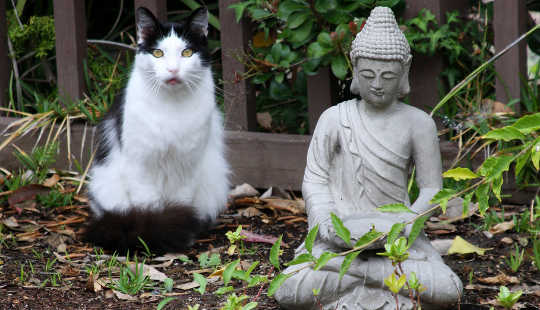Having written a book about madness (Veronika Decides To Die) , I was forced to wonder how many things we do are imposed on us by necessity, or by the absurd. Why wear a tie? Why do clocks run “clockwise”? If we live in a decimal system, why does the day have 24 hours of 60 minutes?
The fact is, many of the rules we obey nowadays have no real foundation. Nevertheless, if we wish to act differently, we are considered “crazy” or “immature”.
Meanwhile, society continues to create some systems which, in the fullness of time, lose their reason for existence, but continue to impose their rules. An interesting Japanese story illustrates what I mean by this.
Meditation and the Cat
A great Zen Buddhist master, who was in charge of the Mayu Kagi monastery, had a cat which was his true passion in life. So, during meditation classes, he kept the cat by his side – in order to make the most of his company.
One morning, the master – who was already quite old – passed away. His best disciple took his place.
– What shall we do with the cat? – asked the other monks.
As a tribute to the memory of their old instructor, the new master decided to allow the cat to continue attending the Zen Buddhist classes.
Some disciples from the neighboring monasteries, traveling through those parts, discovered that, in one of the region’s most renowned temples, a cat took part in the meditation sessions. The story began to spread.
Many years passed. The cat died, but as the students at the monastery were so used to its presence, they soon found another cat. Meanwhile, the other temples began introducing cats in their meditation sessions: they believed the cat was truly responsible for the fame and excellence of Mayu Kagi’s teaching.
A generation passed, and technical treatises began to appear about the importance of the cat in Zen meditation. A university professor developed a thesis – which was accepted by the academic community – that felines have the ability to increase human concentration, and eliminate negative energy. And so, for a whole century, the cat was considered an essential part of Zen Buddhist studies in that region.
Changing the Routine
Until a master appeared who was allergic to animal hair, and decided to remove the cat from his daily exercises with the students.
There was a fierce negative reaction – but the master insisted. Since he was an excellent instructor, the students continued to make the same progress, in spite of the absence of the cat.
Little by little, the monasteries – always in search of new ideas, and already tired of having to feed so many cats – began eliminating the animals from the classes. In twenty years new revolutionary theories began to appear – with very convincing titles such as “The Importance of Meditating Without a Cat”, or “Balancing the Zen Universe by Will Power Alone, Without the Help of Animals”.
Another century passed, and the cat withdrew completely from the meditation rituals in that region. But two hundred years were necessary for everything to return to normal – because during all this time, no one asked why the cat was there.
This article is reprinted from
Paulo Coelho's website, with gratitude.
Book by this author

Warrior of the Light: A Manual
by Paulo Coelho.
Click here for more info and/or to order this book on Amazon.
About the Author
 Paulo Coelho is the author of numerous books, of which the first to become a success, The Alchemist has gone on to sell more than 65 million copies, becoming one of the best-selling books in history. It has been translated into more than 70 languages, the 71st being Maltese, winning the Guinness World Record for most translated book by a living author. Since the publication of The Alchemist, Paulo Coelho has generally written one novel every two years including By the River Piedra I Sat Down and Wept, The Fifth Mountain, Veronika Decides to Die, The Devil and Miss Prym, Eleven Minutes, Like the Flowing River, The Valkyries and The Witch of Portobello. Visit his website at www.paulocoelho.com
Paulo Coelho is the author of numerous books, of which the first to become a success, The Alchemist has gone on to sell more than 65 million copies, becoming one of the best-selling books in history. It has been translated into more than 70 languages, the 71st being Maltese, winning the Guinness World Record for most translated book by a living author. Since the publication of The Alchemist, Paulo Coelho has generally written one novel every two years including By the River Piedra I Sat Down and Wept, The Fifth Mountain, Veronika Decides to Die, The Devil and Miss Prym, Eleven Minutes, Like the Flowing River, The Valkyries and The Witch of Portobello. Visit his website at www.paulocoelho.com





























